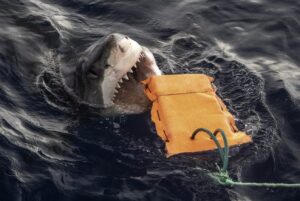You don’t need to be an expert mariner to buy a boat and sail around the world, although it definitely helps, says Kate Collins, who should know. In mid-2024, the 56-year-old Collins and her husband Sean, 57, will jump aboard their new 14.5m boat, Chinook. It will be their home for the next 10 years as they sail the world.
The Collins are at the high end of the retired crowd who seek freedom on the open seas. Their boat, currently being built in Cherbourg, France by the custom manufacturer Garcia, will cost $900,000 — about the cost of a typical home in the pricey Canadian mountain resort of Canmore, where they currently live. But then, they plan to live on the boat for a decade, so it is almost like a house.
Kate herself has been sailing since her childhood near Melbourne, Australia. “I raced a Sabot as a kid and a Hobie Cat as a teenager before moving into keelboats,” she said. Her father was a founding member of the local yacht club.
Sean, on the other hand, grew up in landlocked Edmonton, Alberta, far from any ocean. A former triathlete, he studied kinesiology but worked in IT. He only started sailing 15 years ago, when the two of them met. Both now have their International Certificate of Competency, which allows them to dock in marinas and charter boats.

Sean and Kate Collins.
Nevertheless, they point out that a lot of people begin sailing around the world with little or no experience, in much more modest craft. “A 30-foot yacht is a typical minimum, although you can do it on a 22-footer, and one guy did it on a 16-foot boat,” said Kate. “It depends on how much comfort you want.”
She cites the example of a couple of Alberta university students who pooled their savings, bought a boat for $30,000, then sailed around the world for 14 months. They had virtually no experience: One of them had taken an intro sailing course at a local reservoir. They learned as they went along, and like all sailors, they needed luck on their side.
“Most tropical circumnavigations follow what’s called the Coconut Route,” explained Kate. “That’s Panama Canal-South Pacific-Northern Australia-Suez-Mediterranean-Azores-Caribbean. It’s downwind, following the trade winds, and is relatively straightforward.”

Kate Collins inspects another Garcia boat, similar to theirs. Photo: Sean Collins
Others, lacking the cockiness to do a global circumnavigation on their own, join rallies. Here, a fleet of boats go together, meeting up at a series of checkpoints. They look out for each other, and the organizers provide advanced weather forecasting and help with customs. “It’s like van life,” says Kate.
By far, the greatest number of those living on a sailboat don’t try to go around the world at all. “Most end up in the Caribbean, the east coast of Australia, or Thailand, never more than 10 miles offshore,” says Kate.

Why this boat?
Chinook is named after a warm winter wind in Alberta. “A two-syllable name is also easy to pronounce in different languages,” she says.
As a larger boat, Chinook features some creature comforts lacking in a more basic craft. The two main luxuries: an actual shower and a washing machine. But most of its advanced features are functional. It has dual rudders and a lifting centreboard rather than a keel. These allow the boat to be beached for minor repairs.
They also give it a shallow draft. At 4.5m wide, with a draft of just over 1m, they can slip through the shallow, narrow canals of Europe, traversing from the North Sea to the Mediterranean.
The boat also has 70mm of insulating foam for cold (and hot) climes. The hull is welded rather than riveted. “Rivets sank the Titanic,” says Kate.
Nevertheless, their abilities will allow them to go anywhere, not just the Coconut Route. Their plans include the Northwest Passage, the arctic waterway that 19th century explorers searched and died for.
The polar regions, in particular, require more skill because the denser air makes the seas considerably rougher. “Fifty knots in high latitudes is much worse than 50 knots in the South Pacific,” says Kate. “The Southern Ocean is so bad because the winds are so dense.”
Repairs
Sailors, the old nautical saying goes, travel from one beautiful place to another in order to work on their boat. Indeed, fix-it skills can be at least as important as nautical know-how for a global traveler. Kate is a former engineer and a farmer’s daughter, “which makes me a little handy,” she says.
Both of them also took marine diesel courses, learned how an alternator works, and can service the engine themselves. They will have to change the oil and fuel filters every 100 hours of engine time. They will also bring spares of key items — rudder, fan belts, alternator, starter motor. Finally, it helps to have basic mechanical skills, so you can jury-rig a fix if a pulley or block breaks.
Yearly expenses
They figure that their expenses — insurance, diesel, maintenance, food, etc. — will run them about $30,000 a year. And no, they won’t live mainly on the fish they catch. “On a previous trip, we had two fish in 10 months,” says Kate. They will have a BBQ on board, because charcoal is available around the world, while propane is not.
For an improved bottom line, it’s better to anchor offshore than to dock in marinas, which come with a cost that depends on the place and the length of boat. Daily fees range anywhere from $20 a day in Malaysia to $180 a day at some Australian marinas.
It costs nothing to anchor. If you’re new to a country, you don’t even need to go through customs, as long as you stay on your boat. Before stepping ashore, though, you must check in.
Different countries have rules that make it easier or harder for sailors. With a Canadian passport, for example, you don’t need a visa for 30 days in Thailand and Indonesia, while Malaysia allows six months visa-free. Vietnam would be more popular with boaters, except that its regulations do not distinguish between small pleasure craft and large cargo ships, so plying its coastline requires too much paperwork for most sailors. Indonesia used to be similarly difficult, but they eased their regulations in 2016.
What to avoid
Dangers? Mainly storms and accidentally grounding the boat on an unexpected rock. (You hope that this happens at low tide.) Places to avoid, where piracy is rampant, includes the Horn of Africa, the southern Phillippines, and the Straits of Malacca. Malacca has improved in recent years.
One final thing to avoid: white clothes. “Sunscreen turns it yellow,” says Kate.

From the Collins’ bookshelf: Useful references for any round-the-world sailor. Photo: Jerry Kobalenko






